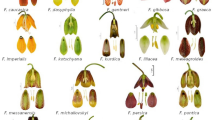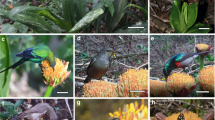Abstract
Myristica fatua is a dioecious specialist species restricted to the endangered, freshwater Myristica swamp forests in the Western Ghats, India. Earlier studies have alluded to pollination by deception in members of the Myristica genus, and thus we examined the pollination ecology comprising floral biology, flower production, flower visitors, and reproductive success in M. fatua and inferred the potential strategies that could permit such deception in this habitat specialist tree. Male flowers provide pollen rewards for an extended period of time while female flowers are rewardless and both sexes are visited by generalist insects, mainly by honeybees and stingless bees. Bee visits were significantly more frequent and longer on male than on female flowers as bees collected pollen from male flowers. We found that flower production patterns create a preponderance of males compared to females in the swamp populations. Using a model of honeybee color vision, we found the distance between the color loci of male and female flowers and based on minimum visual angle subtended by these flowers, we suggest that the two floral sexes cannot be discriminated by bees. Bees are likely deceived by the perceptual similarity of rewardless female flowers to pollen-offering male flowers and pollination is the consequence of foraging errors made by pollinators that encounter largely male–rarely female flower mosaics as they forage among clump-distributed M. fatua trees in the swamp habitat.


Similar content being viewed by others
References
Ackerman JD (1981) Pollination biology of Calypso bulbosa var. occidentalis (Orchidaceae): a food-deception system. Madroño 28:101–110
Ågren J, Schemske DW (1991) Pollination by deceit in a neotropical monoecious herb, Begonia involucrata. Biotropica 23:235–241
Ågren J, Elmqvist T, Tunlid A (1986) Pollination by deceit, floral sex ratios and seed set in dioecious Rubus chamaemorus L. Oecologia 70:332–338
Armstrong J (1997) Pollination by deceit in nutmeg (Myristica insipida, Myristicaceae): floral displays and beetle activity at male and female trees. Am J Bot 84:1266
Armstrong JE, Drummond BA (1986) Floral biology of Myristica fragrans Houtt. (Myristicaceae), the nutmeg of commerce. Biotropica 18:32–38
Armstrong JE, Tucker SC (1986) Floral development in Myristica (Myristicaceae). Am J Bot 73:1131–1143
Armstrong JE, Irvine AK (1989) Flowering, sex ratios, pollen-ovule ratios, fruit set, and reproductive effort of a dioecious tree, Myristica insipida (Myristicaceae), in two different rainforest communities. Am J Bot 76:74–85
Augspurger CK (1983) Phenology, flowering synchrony, and fruit set of six neotropical shrubs. Biotropica 15:257–267
Baddeley A, Turner R (2005) Spatstat: an R Package for analyzing spatial point patterns. J Stat Soft 12:1–42
Baker HG (1976) ‘‘Mistake’’ pollination as a reproductive system with special reference to the Caricaceae. Linn Soc Symp Ser 2:161–169
Barrett SC, Thomson JD (1982) Spatial pattern, floral sex ratios, and fecundity in dioecious Aralia nudicaulis (Araliaceae). Can J Bot 60:1662–1670
Bawa KS (1980a) Evolution of dioecy in flowering plants. Annu Rev Ecol Evol Syst 11:15–39
Bawa KS (1980b) Mimicry of male by female flowers and intrasexual competition for pollinators in Jacaratia dolichaula (D. Smith) Woodson (Caricaceae). Evolution 34:467–474
Beach JH (1981) Pollinator foraging and the evolution of dioecy. Am Nat 118:572–577
Bernhardt P (2000) Convergent evolution and adaptive radiation of beetle-pollinated angiosperms. Plant Syst Evol 222:293–320
Bullock SH, Bawa KS (1981) Sexual dimorphism and the annual flowering pattern in lacaratia dolichaula (D. Smith) Woodson (Caricaceae) in a Costa Rican rain forest. Ecology 62:1494–1504
Castillo RA, Cordero C, Dominguez C (2002) Are reward polymorphisms subject to frequency- and density-dependent selection? Evidence from a monoecious species pollinated by deceit. J Evol Biol 15:544–552
Chandran MDS, Mesta DK (2001) On the conservation of the Myristica swamps of the Western Ghats. In: Uma Shaanker R, Ganeshaiah KN, Bawa KS (eds) Forest genetic resources: status, threats and conservation strategies. Oxford and IBH Publications, New Delhi, pp 1–19
Chandran MDS, Mesta DK, Naik MB (1999) Myristica swamps of Uttara Kannada District. My Forest 35:217–222
Clark PJ, Evans FC (1954) Distance to nearest neighbor as a measure of spatial relationships in populations. Ecology 35:445–453
Dafni A (1984) Mimicry and deception in pollination. Annu Rev Ecol Evol Syst 15:259–278
Dafni A, Lehrer M, Kevan PG (1997) Spatial flower parameters and insect spatial vision. Biol Rev 72:239–282
Deneubourg JL, Aron S, Goss S, Pasteels JM (1987) Error, communication and learning in ant societies. Eur J Oper Res 30:168–172
Dyer FC, Seeley TD (1991) Dance dialects and foraging range in three Asian honey-bee species. Behav Ecol Sociobiol 28:227–233
Dyer AG, Streinzer M, Garcia J (2016) Flower detection and acuity of the Australian native stingless bee Tetragonula carbonaria Sm. J Comp Physiol 202:629–639
Ferdy JB, Gouyon PH, Moret J, Godelle B (1998) Pollinator behavior and deceptive pollination: learning process and floral evolution. Am Nat 152:696–705
Fournier LA (1974) Un método cuantitativo para la medición de características fenolólogicas en árboles. Turrialba 24:422–423
Galizia CG, Kunze J, Gumbert A, Borg-Karlson A-K, Sachse S, Markl C, Menzel R (2005) Relationship of visual and olfactory signal parameters in a food-deceptive flower mimicry system. Behav Ecol 16:159–168
Gaskett AC (2011) Orchid pollination by sexual deception: pollinator perspectives. Biol Rev 86:33–75
Giurfa M, Vorobyev M, Kevan P, Menzel R (1996) Detection of coloured stimuli by honeybees: minimum visual angles and receptor specific contrasts. J Comp Physiol A 178:699–709
Grafen A, Godfray HCJ (1991) Vicarious selection explains some paradoxes in dioecious fig-pollinator systems. Proc R Soc B 245:73–76
Harder LD, Barrett SCH (1992) The energy cost of bee pollination for Pontederia cordata (Pontederiaceae). Funct Ecol 6:1–7
Hempel De Ibarra N, Vorobyev M, Menzel R (2014) Mechanisms, functions and ecology of colour vision in the honeybee. J Comp Physiol A 6:411–433
Hempel De Ibarra N, Langridge KV, Vorobyev M (2015) More than colour attraction: behavioural functions of flower patterns. Curr Opin Insect Sci 12:64–70
House SM (1993) Pollination success in a population of dioecious rain forest trees. Oecologia 96:555–561
Internicola AI, Harder LD (2012) Bumble-bee learning selects for both early and long flowering in food-deceptive plants. Proc R Soc B 279:1538–1543
Internicola AI, Page PA, Bernasconi G, Gigord LD (2007) Competition for pollinator visitation between deceptive and rewarding artificial inflorescences: an experimental test of the effects of floral colour similarity and spatial mingling. Funct Ecol 21:864–872
Internicola AI, Bernasconi G, Gigord LDB (2008) Should food-deceptive species flower before or after rewarding species? An experimental test of pollinator visitation behaviour under contrasting phenologies. J Evol Biol 21:1358–1365
IUCN (2000) The 2000 IUCN red list of threatened species. IUCN, Gland
Jersáková J, Johnson SD, Kindlmann P (2006) Mechanisms and evolution of deceptive pollination in orchids. Biol Rev 81:219–235
Johnson SD, Peter CI, Nilsson LA, Ågren J (2003) Pollination success in a deceptive orchid is enhanced by cooccurring rewarding magnet plants. Ecology 84:2919–2927
Krishna S, Somanathan H (2014) Secondary removal of Myristica fatua (Myristicaceae) seeds by crabs in Myristica swamp forests in India. J Trop Ecol 30(259):263
Krishna S, Somanathan H (2016) Spatiotemporal strategies that facilitate recruitment in a habitat specialist tree species. AoB Plants 8:plw033
Le Corff J, Ågren J, Schemske DW (1998) Floral display, pollinator discrimination, and female reproductive success in two monoecious Begonia species. Ecology 79:1610–1619
Little RJ (1983) A review of floral food deception mimicries with comments on floral mutualism. In: Jones CE, Little RJ (eds) Handbook of experimental pollination ecology. Van Nostrand Reinhold, New York, pp 294–309
Marten-Rodriguez S, Fenster CB (2010) Pollen limitation and reproductive assurance in Antillean Gesnerieae: a specialists vs. generalist comparison. Ecology 91:155–165
Menzel R, Backhaus W (1991) Colour vision in insects. In: Gouras P (ed) Vision and visual dysfunction. Perception of colour. Macmillan, Houndsmills, pp 262–293
Miller-Struttmann NE (2013) Rarity and reproductive biology: habitat specialists reveal a complex relationship. Botany 91:349–359
Patel A, Anstett MC, Hossaert-McKey M, Kjellberg F (1995) Pollinators entering female dioecious figs: why commit suicide? J Evol Biol 8:301–313
Peitsch D, Fietz A, Hertel H, de Souza J, Ventura DF, Menzel R (1992) The spectral input systems of hymenopteran insects and their receptor-based colour vision. J Comp Physiol A 170:23–40
Primack RB (1985) Longevity of individual flowers. Annu Rev Ecol Syst 16:15–37
Priti H, Aravind NA, Umashaanker R, Ravikanth G (2016) Modeling impacts of future climate on the distribution of Myristicaceae species in the Western Ghats, India. Ecol Eng 89:14–23
Pyke GH (1991) What does it cost a plant to produce floral nectar? Nature 350:58–59
R Core Team (2014) R: a language and environment for statistical computing. R Foundation for Statistical Computing, Vienna. http://www.R-project.org/
Raju AJS (2009) Nesting behaviour and foraging ecology of Trigona iridipennis. VDM-Verlag, Saarbrcuken
Renner SS (2006) Rewardless flowers in the angiosperms and the role of insect cognition in their evolution. In: Waser NM, Ollerton J (eds) Plant-pollinator interactions from specialization to generalization. University of Chicago Press, Chicago, pp 123–144
Roby TJ, Jose J, Nair PV (2014) Checklist of flora of Myristica swamps-a critically endangered freshwater ecosystem of Southern Western Ghats of Kerala, India. Indian For 140:608–616
Roy BA, Raguso RA (1997) Olfactory versus visual cues in a floral mimicry system. Oecologia 109:414–426
Sauquet H, Doyle JA, Scharaschkin T, Borsch T, Hilu KW, Chatrou LW, Le Thomas A (2003) Phylogenetic analysis of Magnoliales and Myristicaceae based on multiple data sets: implications for character evolution. Bot J Linn Soc 142:125–186
Schemske DW, Ågren J (1995) Deceit pollination and selection on female flower size in Begonia involucrata: an experimental approach. Evolution 49:207–214
Sharma MV, Armstrong JE (2013) Pollination of Myristica and other nutmegs in natural populations. Trop Conserv Sci 6:595–607
Sharma MV, Shivanna KR (2011) Pollinators, pollination efficiency and fruiting success in a wild nutmeg, Myristica dactyloides. J Trop Ecol 27:405–412
Sinu PA, Sharma M (2013) Insect functional guilds in the flowering canopy of Myristica fatua in a lowland Myristica swamp, central Western Ghats, India. Trop Conserv Sci 6:653–662
Smithson A, Gigord LD (2003) The evolution of empty flowers revisited. Am Nat 161:537–552
Soler CC, Proffit M, Bessière JM, Hossaert-McKey M, Schatz B (2012) Evidence for intersexual chemical mimicry in a dioecious plant. Ecol Lett 15:978–985
Somanathan H, Borges RM (2000) Influence of exploitation on population structure, spatial distribution and reproductive success of dioecious species in a fragmented cloud forest in India. Biol Conserv 94:243–256
Southwick EE (1984) Photosynthate allocation to floral nectar: a neglected energy investment. Ecology 65:1775–1779
Srinivasan MV, Lehrer M (1988) Spatial acuity of honeybee vision and its spectral properties. J Comp Physiol A 162:159–172
Stacy EA, Hamrick JL, Nason JD, Hubbell SP, Foster RB, Condit R (1996) Pollen dispersal in low-density populations of three neotropical tree species. Am Nat 148:275–298
Tremblay RL, Ackerman JD, Zimmerman JK, Calvo RN (2005) Variation in sexual reproduction in orchids and its evolutionary consequences: a spasmodic journey to diversification. Biol J Linn Soc 84:1–54
Vorobyev M, Gumbert A, Kunze J, Giurfa M, Menzel R (1997) Flowers through insect eyes. Israel J Plant Sci 45:93–101
Vorobyev M, Brandt R, Peitsch D, Laughlin SB, Menzel R (2001) Colour thresholds and receptor noise: behavior and physiology compared. Vis Res 41:639–653
Waser NM, Chittka L, Price MV, Williams NM, Ollerton J (1996) Generalization in pollination systems, and why it matters. Ecology 77:1043–1060
Weidenmüller A, Seeley TD (1999) Imprecision in waggle dances of the honeybee (Apis mellifera) for nearby food sources: error or adaptation? Behav Ecol Sociobiol 46:190–199
Willson MF, Ågren J (1989) Differential floral rewards and pollination by deceit in unisexual flowers. Oikos 55:23–29
Acknowledgements
We thank G. Gopalan and Binu for field logistics, the Kerala Forest Department for research permits and Balamurali GS, Freerk Molleman, and two anonymous reviewers for their valuable comments. This study was supported by intramural funds from Indian Institute of Science Education and Research, Thiruvananthapuram and the Department of Biotechnology, Government of India (BT/PR/12720/COE/34/21/2015/A2) to HS. SK acknowledges being funded by a Doctoral Fellowship from the Ministry of Human Resources, Government of India.
Author information
Authors and Affiliations
Corresponding author
Additional information
Communicated by William E. Rogers.
Electronic supplementary material
Below is the link to the electronic supplementary material.
Rights and permissions
About this article
Cite this article
Krishna, S., Somanathan, H. Intersexual mimicry and flowering phenology facilitate pollination in a dioecious habitat specialist species, Myristica fatua (Myristicaceae). Plant Ecol 219, 1247–1257 (2018). https://doi.org/10.1007/s11258-018-0875-6
Received:
Accepted:
Published:
Issue Date:
DOI: https://doi.org/10.1007/s11258-018-0875-6




